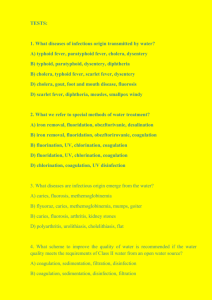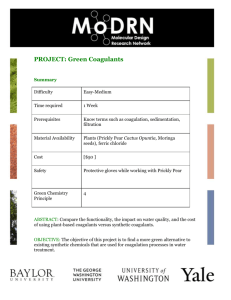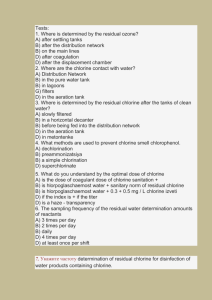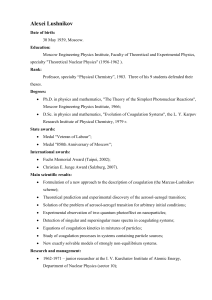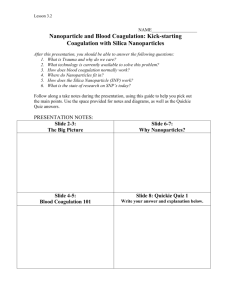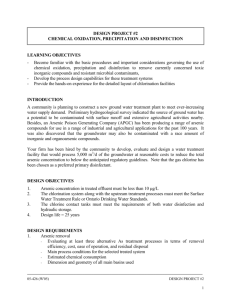***** 1 - TMA.uz
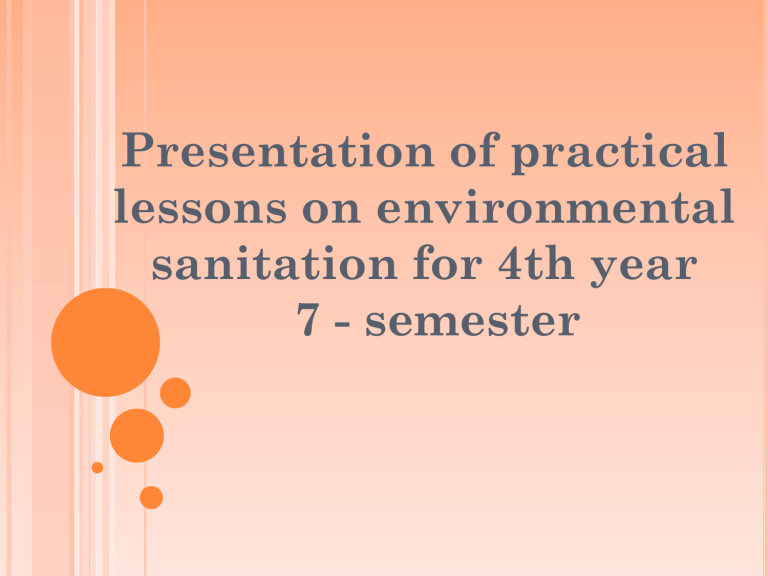
Presentation of practical lessons on environmental sanitation for 4th year
7 - semester
6- Т HEME :
Coagulation water. Method for determining the alkalinity of water hardness. Compilation of health in prison.
Method of determining the optimal dose of coagulant.
Drawing up conclusions about the effectiveness of sanitary coagulation. Meth-ka determine the percentage of active Cl. Compiled by e-san. conclusion. Method for determining the optimum dose and the residual amount of chlorine. Compilation of health in prison.
1
•coagulation value in the preparation of drinking water;
•The essence of the coagulation
2
3
•Coagulants used in the coagulation water and hygiene requirements apply to them
4
•Such that the optimal dose and theoretical
5
•disinfection of water
6
•Reagent water disinfection
7
•Nonchemical methods of water disinfection
P URPOSE OF LESSON :
- Learn the methods for determining the optimal dose of coagulant.
- To teach students the method of evaluating the effectiveness of the coagulation process
Master the techniques of water chlorination.
- Learn how to assess the efficiency of water chlorination
.
S TUDENT MUST KNOW :
Meaning of coagulation in the preparation of drinking water;
Methodology to assess the effectiveness of coagulation.
Methods of water disinfection
Definitions chlorium gelatium water
Types of chlorine and chlorine compounds used in the disinfection of water
T HE STUDENT SHOULD BE ABLE TO :
Methods of determining the optimal dose of coagulant
To determine test dose of coagulant
Evaluate the effectiveness of coagulation
Indicators to assess the compliance of hygienic requirements of GOST 950-2011
C ONTINUED
Method for determining the optimal dose of chlorine
Independently determine the test dose of chlorine
Evaluate the effectiveness of water disinfection
Rate epidemiological indicators of water and compared the findings with GOST 950-2011
S EVERE QUESTIONS
Call coagulants for use of the coagulation process.
Hygienic requirements for coagulants
Coagulation test method?
Conditions for effective coagulation
What is the essence of the coagulation process water?
What factors influence the coagulation process water?
What used coagulants? What is flocculants?
The alkalinity of the water and its role in the coagulation process.
How is the coagulant dose?
How is the effectiveness of coagulation in the waterworks?
CONTINUED
.
How is the selection of doses of chlorine for water chlorination normal doses.
How is the working dose for chlorination of water at the waterworks.
What determines the effectiveness of chlorination.
What is hlorpotrebnost water.
As determined by the percentage of active chlorine.
Where contact with chlorine water.
That such hlorpoglaschaemost water?
What substances applied for the chlorination of drinking water
Coagulation is the process of integration of water and colloidal dispersed particles occurring due to their adhesion by the forces of molecular attraction
Coagulation occurs involving chemical coagulants reagentov-:
Sulfata- aluminum Al 2 (SO 4) 3 ∙ 18 H2O
Oksichlorida- alumina [Al2 (OH) 5] Cl 6 H-2O
Sodium alyuminata- Na Al 102
Iron sulfata- Fe So4 ∙ 7 H2O
Flokulyant - high molecular weight synthetic compounds
Distinguish anionic flocculants (poliacrylamide, K-4, K-6, activated silicic acid) and a cationic IA-2) type.
Hygienic Requirements to coagulants and flocculants: myelotoxicity
- High solubility
Have a bactericidal effect
Should not affect the organoleptic properties of water
The coagulation process is as follows:
Al2 (SO 4)3 +3 Ca (HCo3)2→←2Al (OH)3+ 3 Ca SO4 + 6Co2
Al2 (SO 4)3 +3 Mg (HCo3)2→←2Al (OH)3+ 3 Mg SO4 + 6Co2
Al2 (SO 4)3 +6 H2O →←2Al (OH)3+ 3 SO-4 + 6H
+
There are two types of coagulation coagulation in the free volume
(flocculation occurs in the cells) and contact coagulation (in the thickness of the granular or bulk load of suspended sediment)
.
-
Factors affecting the coagulation process water
Tempera ture
Dose and type of coagulant
The use of flocculants and their views
Alkaline
Water
The amount of suspended solids
Currently, the practice of water chlorination is carried out with gaseous chlorine, hypochlorite bleach or bleach used in the form of finished products, as well as in water is obtained directly upon introduction of ammonia and chlorine
The disinfecting effect of chlorine can be imagined as a complex process in which the bacterial action has as chlorine itself and its hydrolysis products.
-
Reagent water disinfection simple chlorinat ion hyperxlotiu m chloraminazit ion
О[ygeniu m
Oligodyn amic effect of silver double chlorinati on
The problem of water disinfection often solved by using different disinfectants, which are the most widely used chlorine and its compounds.
For disinfection of drinking water is used in two ways:
Water disinfection reagent (chemical) methods
Disinfection of water non-reagent (physical) methods
Nonchemical methods of water disinfection
Gamma irradiat ion
Boiling ultrasound ultrafiolat ion
Processing by current of ultrahigh frequency
Danger factors
Quantity and quality of raw water
Its methods of pre-treatment
Reliability requirements decontamination
Taking into account technical and economic indicators
Terms of delivery reagents availability of transport
Automation process
Liquid chlorine bleach calcium hydrochloride
Sodium hydrochloride chlorine dioxide Chloramine
C ONTROL QUESTIONS
What is the essence of the coagulation process water?
What factors influence the coagulation process water?
What used coagulants? What is flocculants?
The alkalinity of the water and its role in the coagulation process.
How is the coagulant dose?
How is the effectiveness of coagulation in the waterworks?
C ONTINUED
How is the selection of doses of chlorine for water chlorination normal doses.
How is the working dose for chlorination of water at the waterworks.
What determines the effectiveness of chlorination.
What is hlorpotrebnost water.
Where contact with chlorine water.
U SE LITERATURE :
Summary:
1. "Health" under the guidance of prof.
Demidenko NM T. 2003
2. Guide to laboratory work on communal hygiene Goncharuk EI Moscow 1990
3. Sh.T.Otaboev, T.I.Iskandarov,
G.T.Iskandarova "Kommunal hygiene" Tashkent
2010 th.
4 "Kommunal gigienadan Amal mashgulotlar
Uchun ukuv kullanma. "Edited by Academician Iskandarova
TI T. 2006y
5. "Communal Hygiene" E.I.Goncharuk Kiev in
2007 I, II part
Д
ОПОЛНИТЕЛЬНАЯ ЛИТЕРАТУРА
GT Iskandarova "Regional san. gig. problems of protection of water sources "water inpatient population of Uzbekistan. T. 2001.
- Health rules and regulations of planning and building of settlements of the Republic of
Uzbekistan 0003-93
- Sanitary norms of admissible levels of electromagnetic fields of radio frequencies 0064-96
- Sanitary rules of design and maintenance of cemeteries 0086-99
- Health rules and regulations and the optimum allowable building density residential areas of cities of Uzbekistan 0144-03
ПРОДОЛЖЕНИЕ
Sanitary rules and standards for design of residential buildings in the climatic conditions of
Uzbekistan 0146-04
- Health rules and regulations setting up and maintaining public toilets 0151-04
- Hygiene requirements for institutions, organizations, companies and individuals involved in the disinfection activities 0177-04
- Health rules and regulations for the use of mobile phones 0189-05
- Lecture materials
I NTERNET SITES
O'z.Res.SSV veb-sayt WWW.minzdrav.uz
TTA sayti – WWW.tma.uz. htt://web.tma
TMA Wi-Fizone ZiyONet
